Classroom Support: Portfolio on Students with Disabilities Support
VerifiedAdded on 2023/06/11
|6
|2696
|355
Portfolio
AI Summary
This portfolio provides insights into supporting students with disabilities in a classroom environment, covering various strategies, policies, and legislative compliance. It includes practical examples of creating opportunities for success, providing necessary assistance, and following the Disability Discrimination Act 1992. The portfolio highlights strategies teachers use to foster independence and social skills, such as role modeling and effective communication, alongside the role of a teacher's aide in supporting these strategies. Constructive advice and feedback instances are detailed, along with methods to ensure students are comfortable with IEP adjustments. The document further explores problem-solving encouragement, modifications of activities, and ways to promote positive self-concept and self-esteem. Behavior management techniques, understanding the effects of specific disabilities on learning, and assisting students in reaching personal learning goals through oral and non-verbal communication are also discussed. Finally, the portfolio touches on assisting students and parents in accessing advocacy services and ensuring a safe, inclusive learning environment.
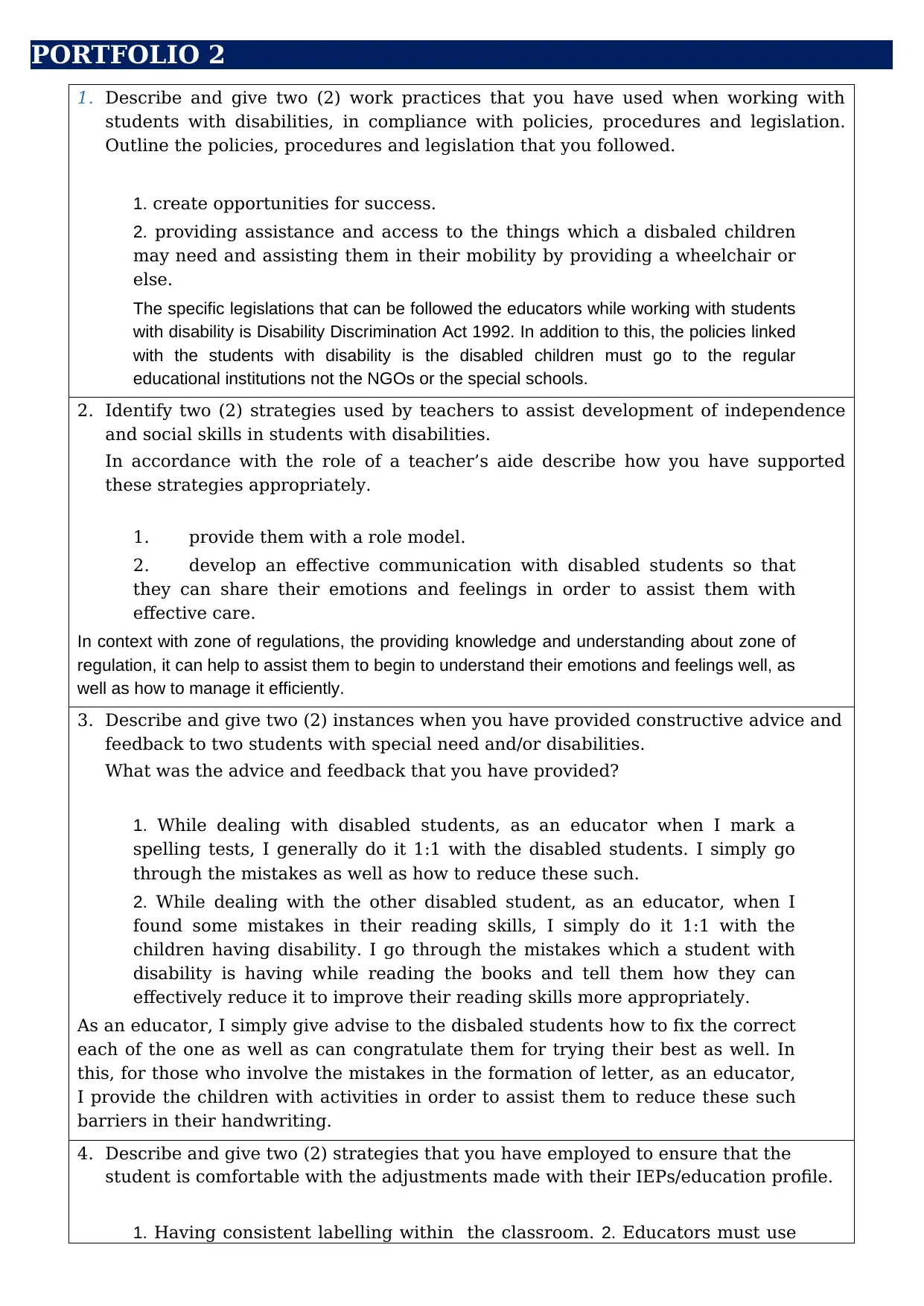
PORTFOLIO 2
1. Describe and give two (2) work practices that you have used when working with
students with disabilities, in compliance with policies, procedures and legislation.
Outline the policies, procedures and legislation that you followed.
1. create opportunities for success.
2. providing assistance and access to the things which a disbaled children
may need and assisting them in their mobility by providing a wheelchair or
else.
The specific legislations that can be followed the educators while working with students
with disability is Disability Discrimination Act 1992. In addition to this, the policies linked
with the students with disability is the disabled children must go to the regular
educational institutions not the NGOs or the special schools.
2. Identify two (2) strategies used by teachers to assist development of independence
and social skills in students with disabilities.
In accordance with the role of a teacher’s aide describe how you have supported
these strategies appropriately.
1. provide them with a role model.
2. develop an effective communication with disabled students so that
they can share their emotions and feelings in order to assist them with
effective care.
In context with zone of regulations, the providing knowledge and understanding about zone of
regulation, it can help to assist them to begin to understand their emotions and feelings well, as
well as how to manage it efficiently.
3. Describe and give two (2) instances when you have provided constructive advice and
feedback to two students with special need and/or disabilities.
What was the advice and feedback that you have provided?
1. While dealing with disabled students, as an educator when I mark a
spelling tests, I generally do it 1:1 with the disabled students. I simply go
through the mistakes as well as how to reduce these such.
2. While dealing with the other disabled student, as an educator, when I
found some mistakes in their reading skills, I simply do it 1:1 with the
children having disability. I go through the mistakes which a student with
disability is having while reading the books and tell them how they can
effectively reduce it to improve their reading skills more appropriately.
As an educator, I simply give advise to the disbaled students how to fix the correct
each of the one as well as can congratulate them for trying their best as well. In
this, for those who involve the mistakes in the formation of letter, as an educator,
I provide the children with activities in order to assist them to reduce these such
barriers in their handwriting.
4. Describe and give two (2) strategies that you have employed to ensure that the
student is comfortable with the adjustments made with their IEPs/education profile.
1. Having consistent labelling within the classroom. 2. Educators must use
1. Describe and give two (2) work practices that you have used when working with
students with disabilities, in compliance with policies, procedures and legislation.
Outline the policies, procedures and legislation that you followed.
1. create opportunities for success.
2. providing assistance and access to the things which a disbaled children
may need and assisting them in their mobility by providing a wheelchair or
else.
The specific legislations that can be followed the educators while working with students
with disability is Disability Discrimination Act 1992. In addition to this, the policies linked
with the students with disability is the disabled children must go to the regular
educational institutions not the NGOs or the special schools.
2. Identify two (2) strategies used by teachers to assist development of independence
and social skills in students with disabilities.
In accordance with the role of a teacher’s aide describe how you have supported
these strategies appropriately.
1. provide them with a role model.
2. develop an effective communication with disabled students so that
they can share their emotions and feelings in order to assist them with
effective care.
In context with zone of regulations, the providing knowledge and understanding about zone of
regulation, it can help to assist them to begin to understand their emotions and feelings well, as
well as how to manage it efficiently.
3. Describe and give two (2) instances when you have provided constructive advice and
feedback to two students with special need and/or disabilities.
What was the advice and feedback that you have provided?
1. While dealing with disabled students, as an educator when I mark a
spelling tests, I generally do it 1:1 with the disabled students. I simply go
through the mistakes as well as how to reduce these such.
2. While dealing with the other disabled student, as an educator, when I
found some mistakes in their reading skills, I simply do it 1:1 with the
children having disability. I go through the mistakes which a student with
disability is having while reading the books and tell them how they can
effectively reduce it to improve their reading skills more appropriately.
As an educator, I simply give advise to the disbaled students how to fix the correct
each of the one as well as can congratulate them for trying their best as well. In
this, for those who involve the mistakes in the formation of letter, as an educator,
I provide the children with activities in order to assist them to reduce these such
barriers in their handwriting.
4. Describe and give two (2) strategies that you have employed to ensure that the
student is comfortable with the adjustments made with their IEPs/education profile.
1. Having consistent labelling within the classroom. 2. Educators must use
Paraphrase This Document
Need a fresh take? Get an instant paraphrase of this document with our AI Paraphraser
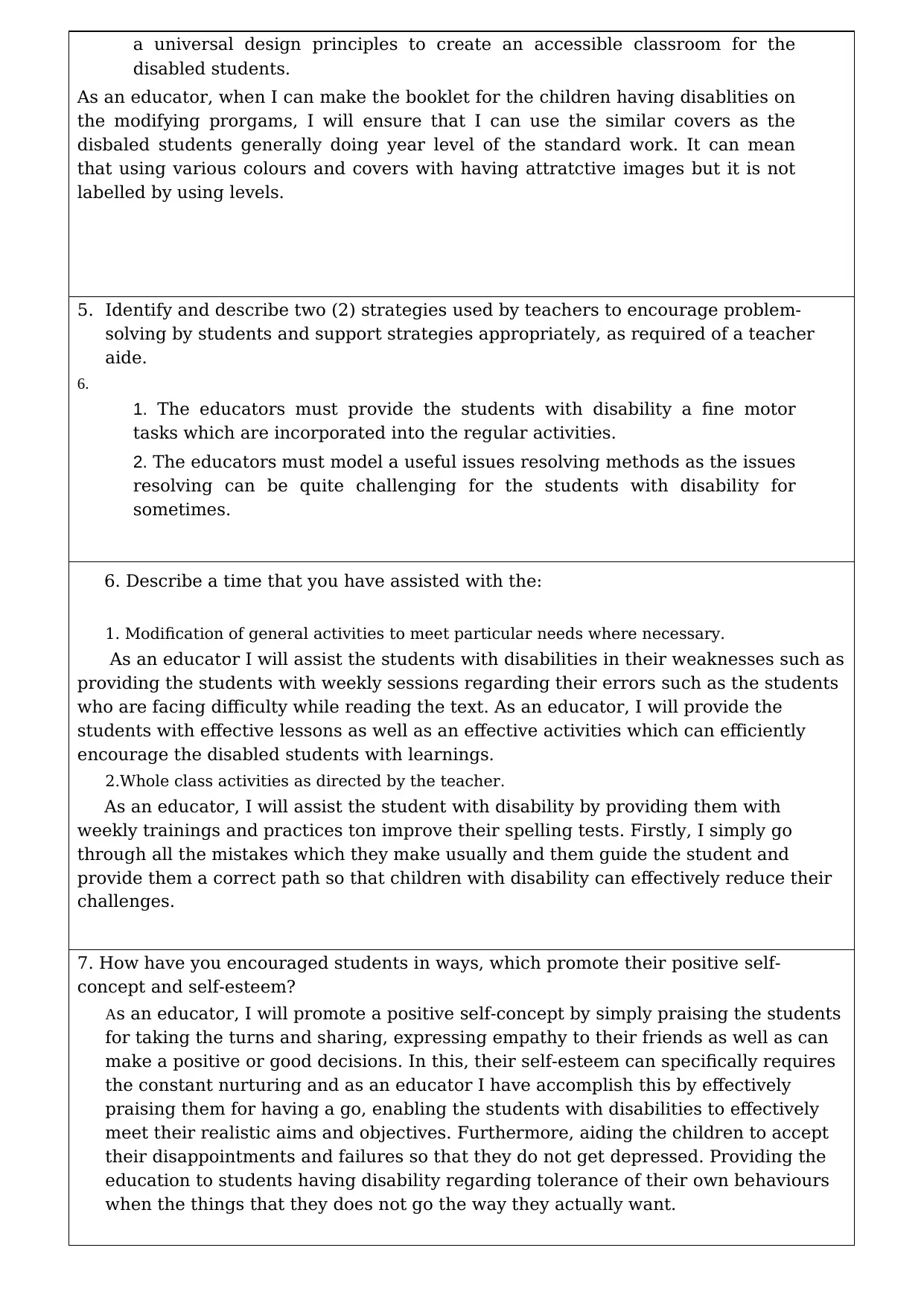
a universal design principles to create an accessible classroom for the
disabled students.
As an educator, when I can make the booklet for the children having disablities on
the modifying prorgams, I will ensure that I can use the similar covers as the
disbaled students generally doing year level of the standard work. It can mean
that using various colours and covers with having attratctive images but it is not
labelled by using levels.
5. Identify and describe two (2) strategies used by teachers to encourage problem-
solving by students and support strategies appropriately, as required of a teacher
aide.
6.
1. The educators must provide the students with disability a fine motor
tasks which are incorporated into the regular activities.
2. The educators must model a useful issues resolving methods as the issues
resolving can be quite challenging for the students with disability for
sometimes.
6. Describe a time that you have assisted with the:
1. Modification of general activities to meet particular needs where necessary.
As an educator I will assist the students with disabilities in their weaknesses such as
providing the students with weekly sessions regarding their errors such as the students
who are facing difficulty while reading the text. As an educator, I will provide the
students with effective lessons as well as an effective activities which can efficiently
encourage the disabled students with learnings.
2.Whole class activities as directed by the teacher.
As an educator, I will assist the student with disability by providing them with
weekly trainings and practices ton improve their spelling tests. Firstly, I simply go
through all the mistakes which they make usually and them guide the student and
provide them a correct path so that children with disability can effectively reduce their
challenges.
7. How have you encouraged students in ways, which promote their positive self-
concept and self-esteem?
As an educator, I will promote a positive self-concept by simply praising the students
for taking the turns and sharing, expressing empathy to their friends as well as can
make a positive or good decisions. In this, their self-esteem can specifically requires
the constant nurturing and as an educator I have accomplish this by effectively
praising them for having a go, enabling the students with disabilities to effectively
meet their realistic aims and objectives. Furthermore, aiding the children to accept
their disappointments and failures so that they do not get depressed. Providing the
education to students having disability regarding tolerance of their own behaviours
when the things that they does not go the way they actually want.
disabled students.
As an educator, when I can make the booklet for the children having disablities on
the modifying prorgams, I will ensure that I can use the similar covers as the
disbaled students generally doing year level of the standard work. It can mean
that using various colours and covers with having attratctive images but it is not
labelled by using levels.
5. Identify and describe two (2) strategies used by teachers to encourage problem-
solving by students and support strategies appropriately, as required of a teacher
aide.
6.
1. The educators must provide the students with disability a fine motor
tasks which are incorporated into the regular activities.
2. The educators must model a useful issues resolving methods as the issues
resolving can be quite challenging for the students with disability for
sometimes.
6. Describe a time that you have assisted with the:
1. Modification of general activities to meet particular needs where necessary.
As an educator I will assist the students with disabilities in their weaknesses such as
providing the students with weekly sessions regarding their errors such as the students
who are facing difficulty while reading the text. As an educator, I will provide the
students with effective lessons as well as an effective activities which can efficiently
encourage the disabled students with learnings.
2.Whole class activities as directed by the teacher.
As an educator, I will assist the student with disability by providing them with
weekly trainings and practices ton improve their spelling tests. Firstly, I simply go
through all the mistakes which they make usually and them guide the student and
provide them a correct path so that children with disability can effectively reduce their
challenges.
7. How have you encouraged students in ways, which promote their positive self-
concept and self-esteem?
As an educator, I will promote a positive self-concept by simply praising the students
for taking the turns and sharing, expressing empathy to their friends as well as can
make a positive or good decisions. In this, their self-esteem can specifically requires
the constant nurturing and as an educator I have accomplish this by effectively
praising them for having a go, enabling the students with disabilities to effectively
meet their realistic aims and objectives. Furthermore, aiding the children to accept
their disappointments and failures so that they do not get depressed. Providing the
education to students having disability regarding tolerance of their own behaviours
when the things that they does not go the way they actually want.
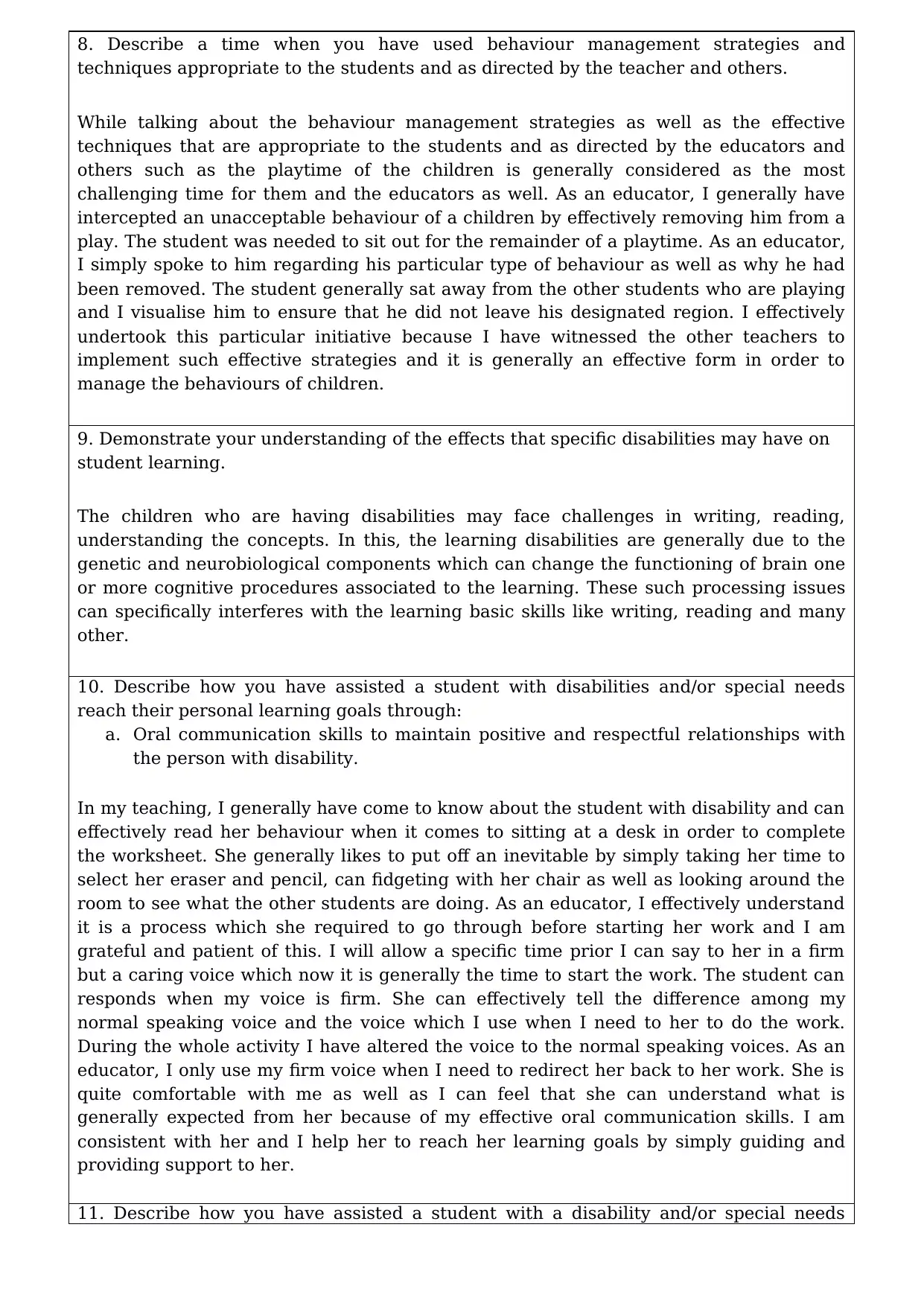
8. Describe a time when you have used behaviour management strategies and
techniques appropriate to the students and as directed by the teacher and others.
While talking about the behaviour management strategies as well as the effective
techniques that are appropriate to the students and as directed by the educators and
others such as the playtime of the children is generally considered as the most
challenging time for them and the educators as well. As an educator, I generally have
intercepted an unacceptable behaviour of a children by effectively removing him from a
play. The student was needed to sit out for the remainder of a playtime. As an educator,
I simply spoke to him regarding his particular type of behaviour as well as why he had
been removed. The student generally sat away from the other students who are playing
and I visualise him to ensure that he did not leave his designated region. I effectively
undertook this particular initiative because I have witnessed the other teachers to
implement such effective strategies and it is generally an effective form in order to
manage the behaviours of children.
9. Demonstrate your understanding of the effects that specific disabilities may have on
student learning.
The children who are having disabilities may face challenges in writing, reading,
understanding the concepts. In this, the learning disabilities are generally due to the
genetic and neurobiological components which can change the functioning of brain one
or more cognitive procedures associated to the learning. These such processing issues
can specifically interferes with the learning basic skills like writing, reading and many
other.
10. Describe how you have assisted a student with disabilities and/or special needs
reach their personal learning goals through:
a. Oral communication skills to maintain positive and respectful relationships with
the person with disability.
In my teaching, I generally have come to know about the student with disability and can
effectively read her behaviour when it comes to sitting at a desk in order to complete
the worksheet. She generally likes to put off an inevitable by simply taking her time to
select her eraser and pencil, can fidgeting with her chair as well as looking around the
room to see what the other students are doing. As an educator, I effectively understand
it is a process which she required to go through before starting her work and I am
grateful and patient of this. I will allow a specific time prior I can say to her in a firm
but a caring voice which now it is generally the time to start the work. The student can
responds when my voice is firm. She can effectively tell the difference among my
normal speaking voice and the voice which I use when I need to her to do the work.
During the whole activity I have altered the voice to the normal speaking voices. As an
educator, I only use my firm voice when I need to redirect her back to her work. She is
quite comfortable with me as well as I can feel that she can understand what is
generally expected from her because of my effective oral communication skills. I am
consistent with her and I help her to reach her learning goals by simply guiding and
providing support to her.
11. Describe how you have assisted a student with a disability and/or special needs
techniques appropriate to the students and as directed by the teacher and others.
While talking about the behaviour management strategies as well as the effective
techniques that are appropriate to the students and as directed by the educators and
others such as the playtime of the children is generally considered as the most
challenging time for them and the educators as well. As an educator, I generally have
intercepted an unacceptable behaviour of a children by effectively removing him from a
play. The student was needed to sit out for the remainder of a playtime. As an educator,
I simply spoke to him regarding his particular type of behaviour as well as why he had
been removed. The student generally sat away from the other students who are playing
and I visualise him to ensure that he did not leave his designated region. I effectively
undertook this particular initiative because I have witnessed the other teachers to
implement such effective strategies and it is generally an effective form in order to
manage the behaviours of children.
9. Demonstrate your understanding of the effects that specific disabilities may have on
student learning.
The children who are having disabilities may face challenges in writing, reading,
understanding the concepts. In this, the learning disabilities are generally due to the
genetic and neurobiological components which can change the functioning of brain one
or more cognitive procedures associated to the learning. These such processing issues
can specifically interferes with the learning basic skills like writing, reading and many
other.
10. Describe how you have assisted a student with disabilities and/or special needs
reach their personal learning goals through:
a. Oral communication skills to maintain positive and respectful relationships with
the person with disability.
In my teaching, I generally have come to know about the student with disability and can
effectively read her behaviour when it comes to sitting at a desk in order to complete
the worksheet. She generally likes to put off an inevitable by simply taking her time to
select her eraser and pencil, can fidgeting with her chair as well as looking around the
room to see what the other students are doing. As an educator, I effectively understand
it is a process which she required to go through before starting her work and I am
grateful and patient of this. I will allow a specific time prior I can say to her in a firm
but a caring voice which now it is generally the time to start the work. The student can
responds when my voice is firm. She can effectively tell the difference among my
normal speaking voice and the voice which I use when I need to her to do the work.
During the whole activity I have altered the voice to the normal speaking voices. As an
educator, I only use my firm voice when I need to redirect her back to her work. She is
quite comfortable with me as well as I can feel that she can understand what is
generally expected from her because of my effective oral communication skills. I am
consistent with her and I help her to reach her learning goals by simply guiding and
providing support to her.
11. Describe how you have assisted a student with a disability and/or special needs
You're viewing a preview
Unlock full access by subscribing today!
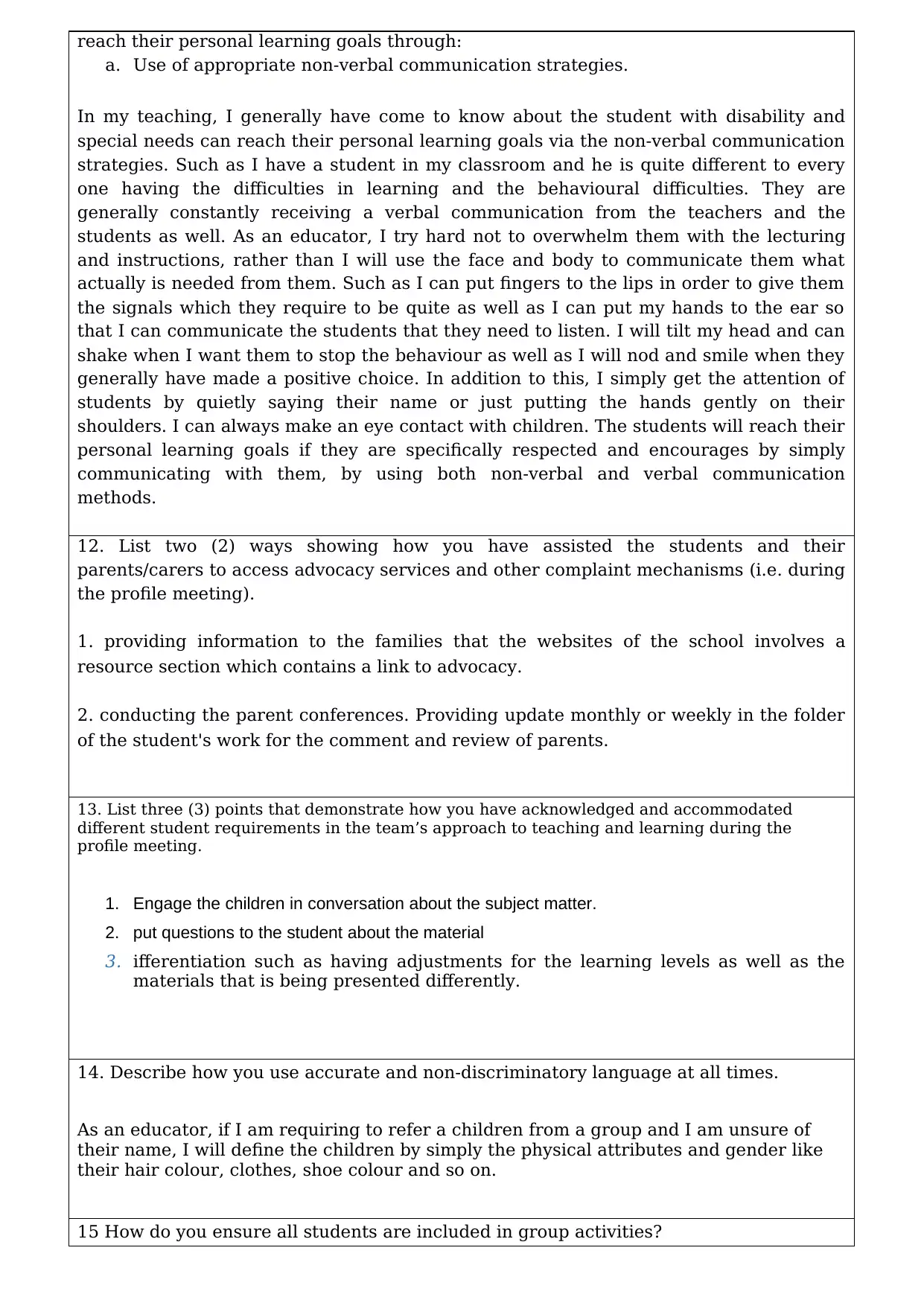
reach their personal learning goals through:
a. Use of appropriate non-verbal communication strategies.
In my teaching, I generally have come to know about the student with disability and
special needs can reach their personal learning goals via the non-verbal communication
strategies. Such as I have a student in my classroom and he is quite different to every
one having the difficulties in learning and the behavioural difficulties. They are
generally constantly receiving a verbal communication from the teachers and the
students as well. As an educator, I try hard not to overwhelm them with the lecturing
and instructions, rather than I will use the face and body to communicate them what
actually is needed from them. Such as I can put fingers to the lips in order to give them
the signals which they require to be quite as well as I can put my hands to the ear so
that I can communicate the students that they need to listen. I will tilt my head and can
shake when I want them to stop the behaviour as well as I will nod and smile when they
generally have made a positive choice. In addition to this, I simply get the attention of
students by quietly saying their name or just putting the hands gently on their
shoulders. I can always make an eye contact with children. The students will reach their
personal learning goals if they are specifically respected and encourages by simply
communicating with them, by using both non-verbal and verbal communication
methods.
12. List two (2) ways showing how you have assisted the students and their
parents/carers to access advocacy services and other complaint mechanisms (i.e. during
the profile meeting).
1. providing information to the families that the websites of the school involves a
resource section which contains a link to advocacy.
2. conducting the parent conferences. Providing update monthly or weekly in the folder
of the student's work for the comment and review of parents.
13. List three (3) points that demonstrate how you have acknowledged and accommodated
different student requirements in the team’s approach to teaching and learning during the
profile meeting.
1. Engage the children in conversation about the subject matter.
2. put questions to the student about the material
3. ifferentiation such as having adjustments for the learning levels as well as the
materials that is being presented differently.
14. Describe how you use accurate and non-discriminatory language at all times.
As an educator, if I am requiring to refer a children from a group and I am unsure of
their name, I will define the children by simply the physical attributes and gender like
their hair colour, clothes, shoe colour and so on.
15 How do you ensure all students are included in group activities?
a. Use of appropriate non-verbal communication strategies.
In my teaching, I generally have come to know about the student with disability and
special needs can reach their personal learning goals via the non-verbal communication
strategies. Such as I have a student in my classroom and he is quite different to every
one having the difficulties in learning and the behavioural difficulties. They are
generally constantly receiving a verbal communication from the teachers and the
students as well. As an educator, I try hard not to overwhelm them with the lecturing
and instructions, rather than I will use the face and body to communicate them what
actually is needed from them. Such as I can put fingers to the lips in order to give them
the signals which they require to be quite as well as I can put my hands to the ear so
that I can communicate the students that they need to listen. I will tilt my head and can
shake when I want them to stop the behaviour as well as I will nod and smile when they
generally have made a positive choice. In addition to this, I simply get the attention of
students by quietly saying their name or just putting the hands gently on their
shoulders. I can always make an eye contact with children. The students will reach their
personal learning goals if they are specifically respected and encourages by simply
communicating with them, by using both non-verbal and verbal communication
methods.
12. List two (2) ways showing how you have assisted the students and their
parents/carers to access advocacy services and other complaint mechanisms (i.e. during
the profile meeting).
1. providing information to the families that the websites of the school involves a
resource section which contains a link to advocacy.
2. conducting the parent conferences. Providing update monthly or weekly in the folder
of the student's work for the comment and review of parents.
13. List three (3) points that demonstrate how you have acknowledged and accommodated
different student requirements in the team’s approach to teaching and learning during the
profile meeting.
1. Engage the children in conversation about the subject matter.
2. put questions to the student about the material
3. ifferentiation such as having adjustments for the learning levels as well as the
materials that is being presented differently.
14. Describe how you use accurate and non-discriminatory language at all times.
As an educator, if I am requiring to refer a children from a group and I am unsure of
their name, I will define the children by simply the physical attributes and gender like
their hair colour, clothes, shoe colour and so on.
15 How do you ensure all students are included in group activities?
Paraphrase This Document
Need a fresh take? Get an instant paraphrase of this document with our AI Paraphraser
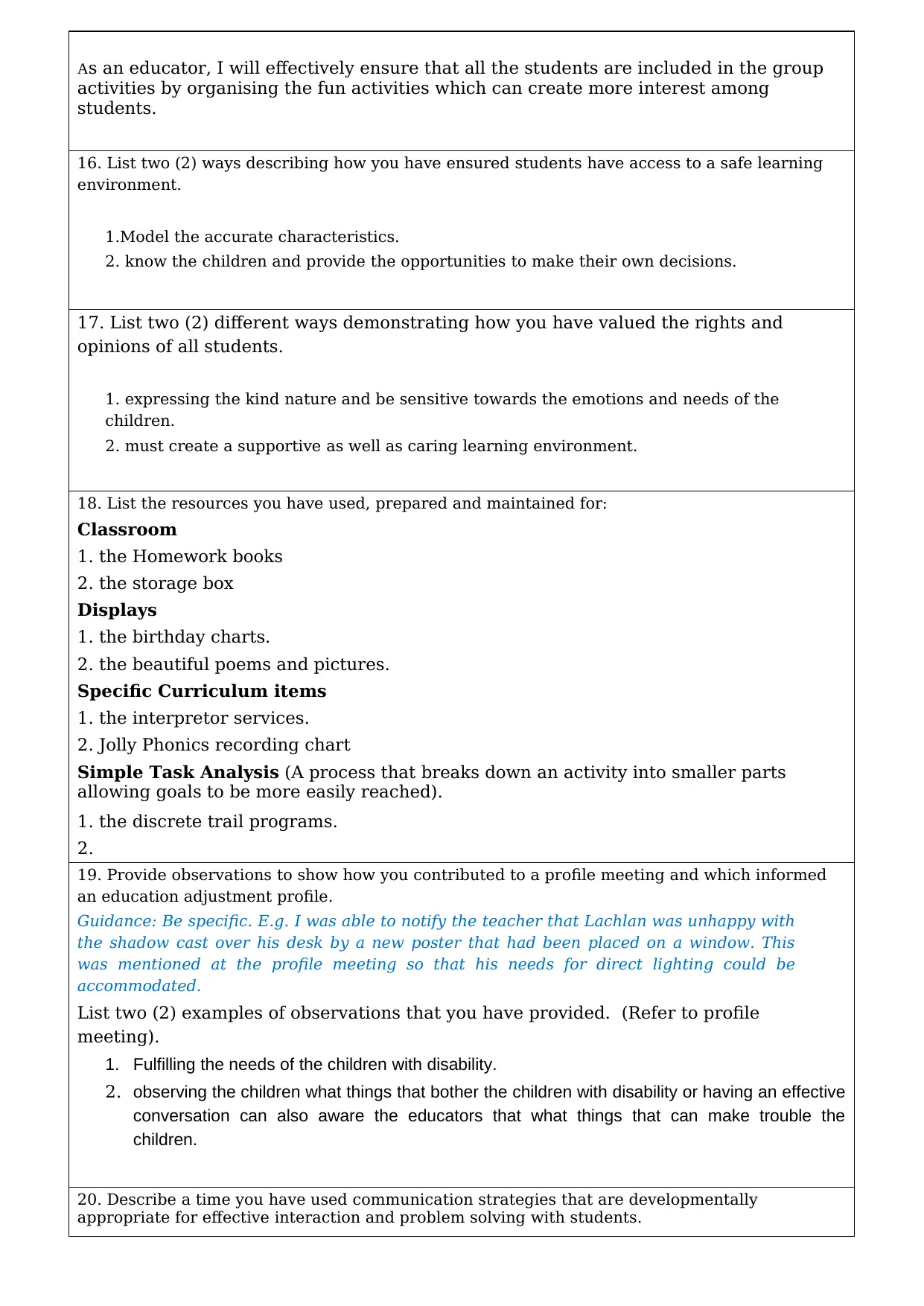
As an educator, I will effectively ensure that all the students are included in the group
activities by organising the fun activities which can create more interest among
students.
16. List two (2) ways describing how you have ensured students have access to a safe learning
environment.
1.Model the accurate characteristics.
2. know the children and provide the opportunities to make their own decisions.
17. List two (2) different ways demonstrating how you have valued the rights and
opinions of all students.
1. expressing the kind nature and be sensitive towards the emotions and needs of the
children.
2. must create a supportive as well as caring learning environment.
18. List the resources you have used, prepared and maintained for:
Classroom
1. the Homework books
2. the storage box
Displays
1. the birthday charts.
2. the beautiful poems and pictures.
Specific Curriculum items
1. the interpretor services.
2. Jolly Phonics recording chart
Simple Task Analysis (A process that breaks down an activity into smaller parts
allowing goals to be more easily reached).
1. the discrete trail programs.
2.
19. Provide observations to show how you contributed to a profile meeting and which informed
an education adjustment profile.
Guidance: Be specific. E.g. I was able to notify the teacher that Lachlan was unhappy with
the shadow cast over his desk by a new poster that had been placed on a window. This
was mentioned at the profile meeting so that his needs for direct lighting could be
accommodated.
List two (2) examples of observations that you have provided. (Refer to profile
meeting).
1. Fulfilling the needs of the children with disability.
2. observing the children what things that bother the children with disability or having an effective
conversation can also aware the educators that what things that can make trouble the
children.
20. Describe a time you have used communication strategies that are developmentally
appropriate for effective interaction and problem solving with students.
activities by organising the fun activities which can create more interest among
students.
16. List two (2) ways describing how you have ensured students have access to a safe learning
environment.
1.Model the accurate characteristics.
2. know the children and provide the opportunities to make their own decisions.
17. List two (2) different ways demonstrating how you have valued the rights and
opinions of all students.
1. expressing the kind nature and be sensitive towards the emotions and needs of the
children.
2. must create a supportive as well as caring learning environment.
18. List the resources you have used, prepared and maintained for:
Classroom
1. the Homework books
2. the storage box
Displays
1. the birthday charts.
2. the beautiful poems and pictures.
Specific Curriculum items
1. the interpretor services.
2. Jolly Phonics recording chart
Simple Task Analysis (A process that breaks down an activity into smaller parts
allowing goals to be more easily reached).
1. the discrete trail programs.
2.
19. Provide observations to show how you contributed to a profile meeting and which informed
an education adjustment profile.
Guidance: Be specific. E.g. I was able to notify the teacher that Lachlan was unhappy with
the shadow cast over his desk by a new poster that had been placed on a window. This
was mentioned at the profile meeting so that his needs for direct lighting could be
accommodated.
List two (2) examples of observations that you have provided. (Refer to profile
meeting).
1. Fulfilling the needs of the children with disability.
2. observing the children what things that bother the children with disability or having an effective
conversation can also aware the educators that what things that can make trouble the
children.
20. Describe a time you have used communication strategies that are developmentally
appropriate for effective interaction and problem solving with students.
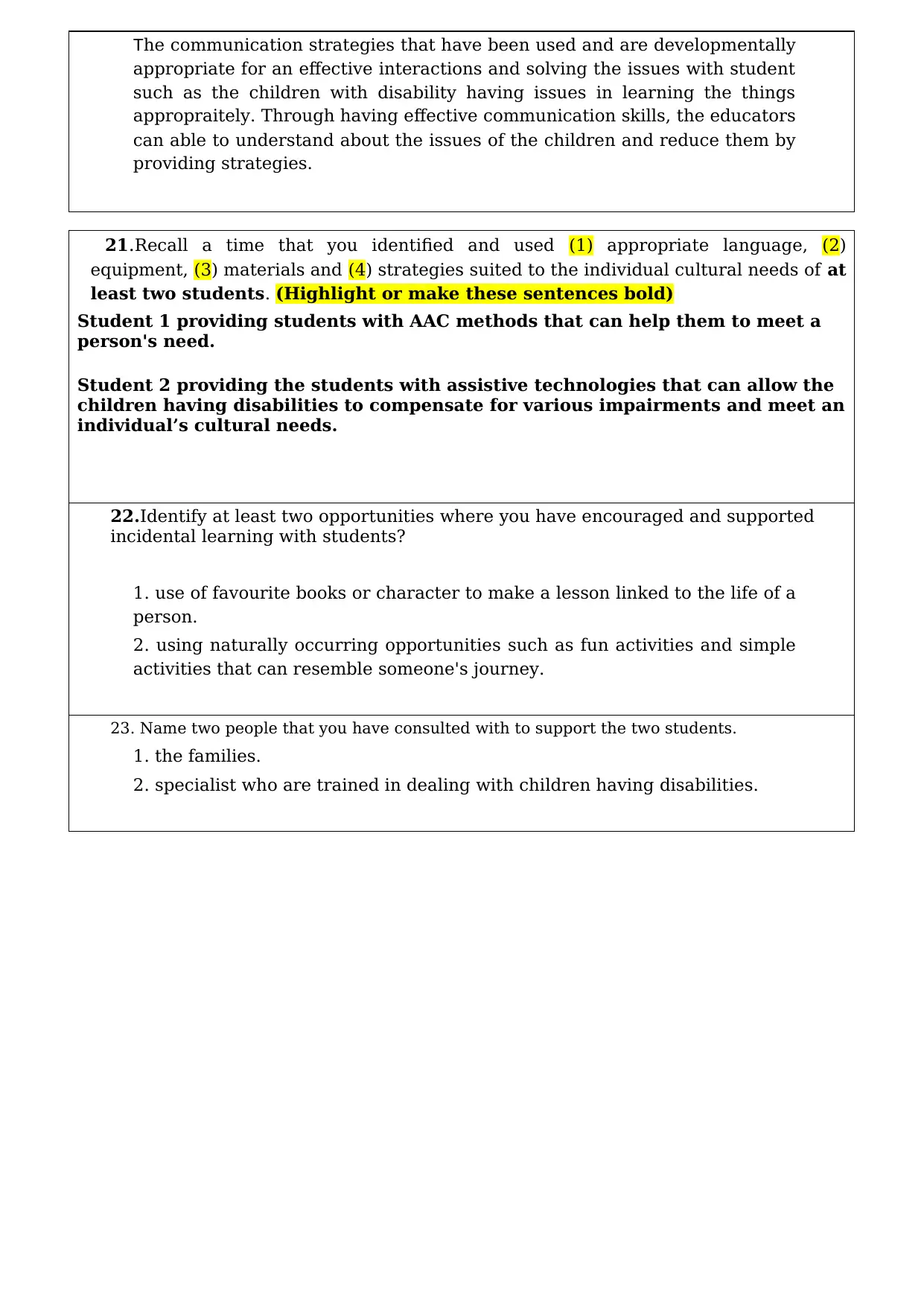
The communication strategies that have been used and are developmentally
appropriate for an effective interactions and solving the issues with student
such as the children with disability having issues in learning the things
appropraitely. Through having effective communication skills, the educators
can able to understand about the issues of the children and reduce them by
providing strategies.
21.Recall a time that you identified and used (1) appropriate language, (2)
equipment, (3) materials and (4) strategies suited to the individual cultural needs of at
least two students. (Highlight or make these sentences bold)
Student 1 providing students with AAC methods that can help them to meet a
person's need.
Student 2 providing the students with assistive technologies that can allow the
children having disabilities to compensate for various impairments and meet an
individual’s cultural needs.
22.Identify at least two opportunities where you have encouraged and supported
incidental learning with students?
1. use of favourite books or character to make a lesson linked to the life of a
person.
2. using naturally occurring opportunities such as fun activities and simple
activities that can resemble someone's journey.
23. Name two people that you have consulted with to support the two students.
1. the families.
2. specialist who are trained in dealing with children having disabilities.
appropriate for an effective interactions and solving the issues with student
such as the children with disability having issues in learning the things
appropraitely. Through having effective communication skills, the educators
can able to understand about the issues of the children and reduce them by
providing strategies.
21.Recall a time that you identified and used (1) appropriate language, (2)
equipment, (3) materials and (4) strategies suited to the individual cultural needs of at
least two students. (Highlight or make these sentences bold)
Student 1 providing students with AAC methods that can help them to meet a
person's need.
Student 2 providing the students with assistive technologies that can allow the
children having disabilities to compensate for various impairments and meet an
individual’s cultural needs.
22.Identify at least two opportunities where you have encouraged and supported
incidental learning with students?
1. use of favourite books or character to make a lesson linked to the life of a
person.
2. using naturally occurring opportunities such as fun activities and simple
activities that can resemble someone's journey.
23. Name two people that you have consulted with to support the two students.
1. the families.
2. specialist who are trained in dealing with children having disabilities.
You're viewing a preview
Unlock full access by subscribing today!
1 out of 6
Related Documents
Your All-in-One AI-Powered Toolkit for Academic Success.
+13062052269
info@desklib.com
Available 24*7 on WhatsApp / Email
![[object Object]](/_next/static/media/star-bottom.7253800d.svg)
Unlock your academic potential
© 2024 | Zucol Services PVT LTD | All rights reserved.





